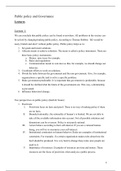Summary
Summary Public policy and governance partial exam/deeltentamen 1
- Course
- Institution
- Book
This is a summary of the course public policy and governance from the bachelor politicologie/political science at the UvA. Most of the summary is in English. However, one book was in Dutch and is therefore also summarized in Dutch. I passed this exam with an 8.2, so I'm sure you will pass with this...
[Show more]




